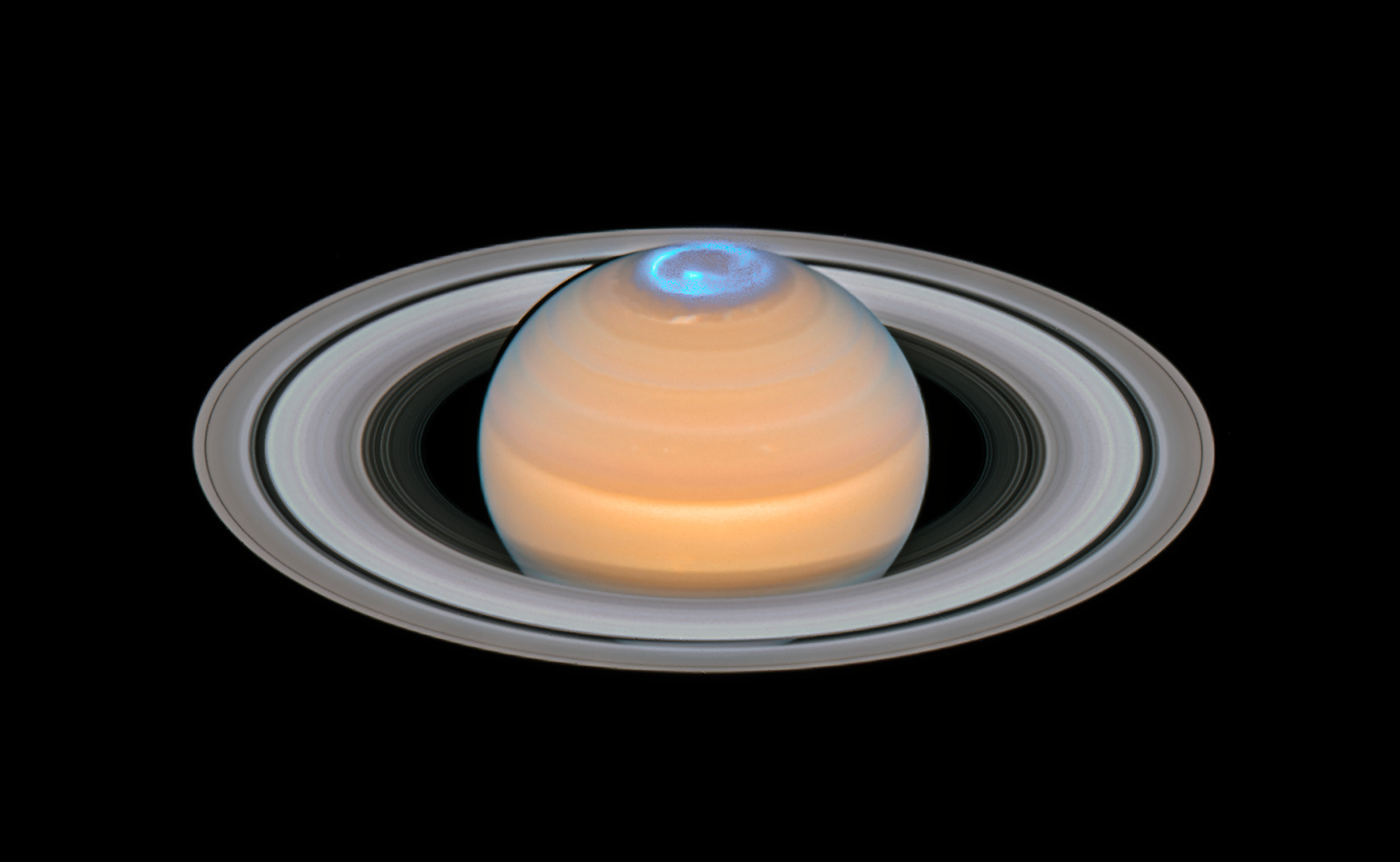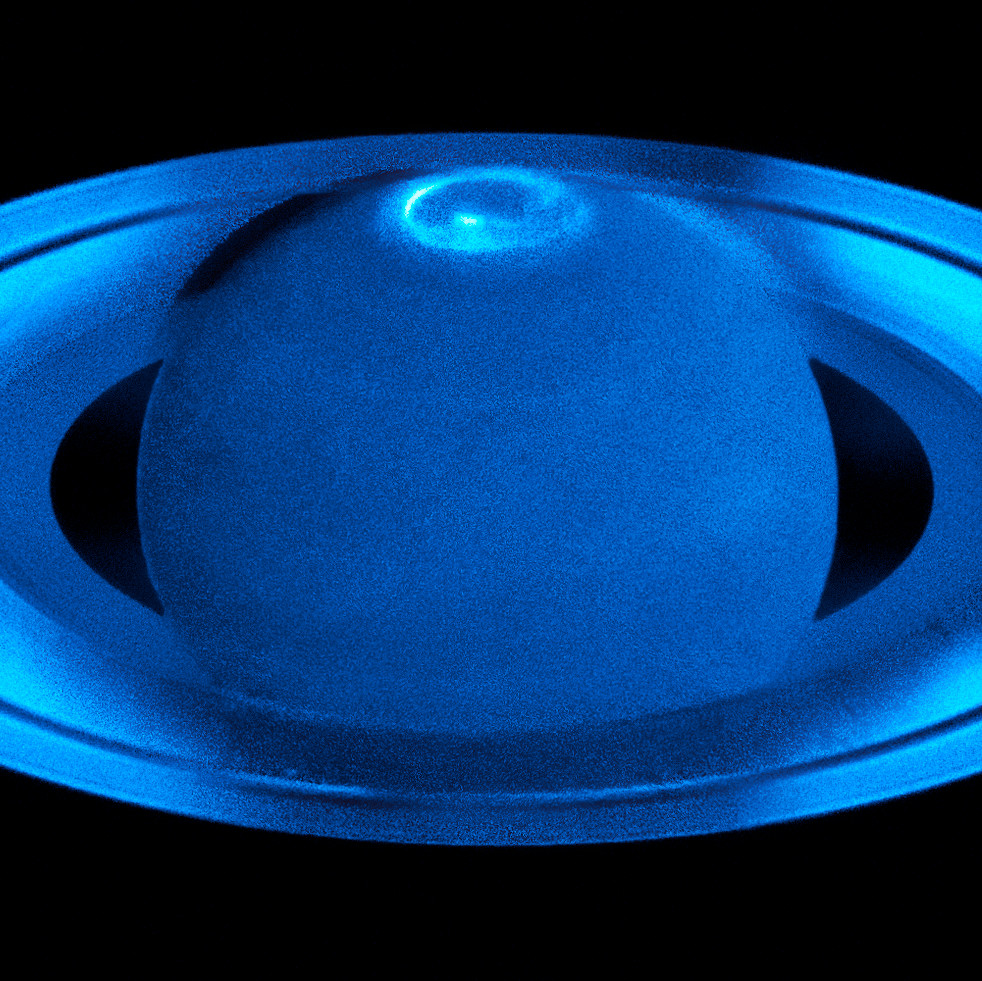30 August 2018
WASHINGTON — Astronomers using the Hubble Space telescope have taken a series of images featuring the fluttering auroras at the north pole of Saturn. The observations were taken in ultraviolet light and the resulting images provide astronomers with the most comprehensive picture so far of Saturn’s northern aurora.
In 2017, over a period of seven months, the NASA/ESA Hubble Space Telescope took images of auroras above Saturn’s north pole region using the Space Telescope Imaging Spectrograph. The observations were taken before and after the Saturnian northern summer solstice. These conditions provided the best achievable viewing of the northern auroral region for Hubble.
The new observations are detailed in a new study in Geophysical Research Letters, a journal of the American Geophysical Union.

This image is a composite of observations made of Saturn in early 2018 in the optical and of the auroras on Saturn’s north pole region, made in 2017. In contrast to the auroras on Earth the auroras on Saturn are only visible in the ultraviolet — a part of the electromagnetic spectrum blocked by Earth’s atmosphere — and therefore astronomers have to rely on space telescopes to study them.
Credit: ESA/Hubble, NASA, A. Simon (GSFC) and the OPAL Team, J. DePasquale (STScI), L. Lamy (Observatoire de Paris)
On Earth, auroras are mainly created by particles originally emitted by the Sun in the form of solar wind. When this stream of electrically charged particles gets close to our planet, it interacts with the magnetic field, which acts as a gigantic shield. While it protects Earth’s environment from solar wind particles, it can also trap a small fraction of them. Particles trapped within the magnetosphere — the region of space surrounding Earth in which charged particles are affected by its magnetic field — can be energized and then follow the magnetic field lines down to the magnetic poles. There, they interact with oxygen and nitrogen atoms in the upper layers of the atmosphere, creating the flickering, colorful lights visible in the polar regions here on Earth.
However, these auroras are not unique to Earth. Other planets in our Solar System have been found to have similar auroras. Among them are the four gas giants Jupiter, Saturn, Uranus and Neptune. Because the atmosphere of each of the four outer planets in the Solar System is – unlike the Earth – dominated by hydrogen, Saturn’s auroras can only be seen in ultraviolet wavelengths — a part of the electromagnetic spectrum which can only be studied from space.

The image, observed with the Space Telescope Imaging Spectrograph in the ultraviolet, shows the auroras surrounding Saturn’s north pole region. In comparing the different observations it became clear that Saturn’s auroras show a rich variety of emissions with highly variable localised features. The variability of the auroras is influenced by both the solar wind and the rapid rotation of Saturn.
Credit: ESA/Hubble, NASA & L. Lamy (Observatoire de Paris)
Hubble allowed researchers to monitor the behavior of the auroras at Saturn’s north pole over an extended period of time. The Hubble observations were coordinated with the “Grand Finale” of the Cassini spacecraft, when the spacecraft simultaneously probed the auroral regions of Saturn. The Hubble data allowed astronomers to learn more about Saturn’s magnetosphere, which is the largest of any planet in the Solar System other than Jupiter.
The images show a rich variety of emissions with highly variable localized features. The variability of the auroras is influenced by both the solar wind and the rapid rotation of Saturn, which lasts only about 11 hours. On top of this, the northern aurora displays two distinct peaks in brightness — at dawn and just before midnight. The latter peak, unreported before, seems specific to the interaction of the solar wind with the magnetosphere at Saturn’s solstice.
Hubble has studied Saturn’s auroras in the past. In 2004, it studied the southern auroras shortly after the southern solstice and in 2009 it took advantage of a rare opportunity to record Saturn when its rings were edge-on. This allowed Hubble to observe both poles and their auroras simultaneously.
This video uses different observations of Saturn: While the observations in the optical, showing the planet itself, were made in 2018, the observations of the auroras were collected in 2017. The video shows how the auroras in Saturn’s northern regions vary over time. The variability of the auroras is influenced by both the solar wind and the rapid rotation of Saturn. Credit: ESA/Hubble, NASA & L. Lamy (Observatoire de Paris)
This video shows the evolution of Saturn’s auroras as they have been observed in 2017. The variability of the auroras is influenced by both the solar wind and the rapid rotation of Saturn. Credit: ESA/Hubble, NASA & L. Lamy (Observatoire de Paris)
###
The American Geophysical Union is dedicated to advancing the Earth and space sciences for the benefit of humanity through its scholarly publications, conferences, and outreach programs. AGU is a not-for-profit, professional, scientific organization representing 60,000 members in 137 countries. Join the conversation on Facebook, Twitter, YouTube, and our other social media channels.
The Hubble Space Telescope is a project of international cooperation between ESA and NASA.
Notes for Journalists
This paper is freely available for 30 days. Journalists and public information officers (PIOs) can download a PDF copy of the article by clicking on this link: https://agupubs.onlinelibrary.wiley.com/doi/10.1029/2018GL078211
Journalists and PIOs may also order a copy of the final paper by emailing a request to Nanci Bompey at [email protected]. Please provide your name, the name of your publication, and your phone number.
Neither the paper nor this press release is under embargo.
“Saturn's northern aurorae at solstice from HST observations coordinated with Cassini's Grand Finale”
Authors:
L. Lamy: LESIA, Obs. de Paris, PSL, CNRS, UPMC, Univ. Paris Diderot, Meudon, France;
R. Prangé: LESIA, Obs. de Paris, PSL, CNRS, UPMC, Univ. Paris Diderot, Meudon, France;
C. Tao: National Institute of Information and Communications Technology, Tokyo, Japan;
T. Kim: Center for Space Plasma and Aeronomic Research, University of Alabama, Huntsville, USA;
S. V. Badman: Department of Physics, Lancaster University, Lancaster, UK;
P. Zarka and B. Cecconi: LESIA, Obs. de Paris, PSL, CNRS, UPMC, Univ. Paris Diderot, Meudon, France;
W. S. Kurth: Department of Physics and Astronomy, University of Iowa, Iowa City, USA;
W. Pryor: Department of Science, Central Arizona College, Coolidge, USA;
E. Bunce: Department of Physics and Astronomy, University of Leicester, Leicester, UK;
A. Radioti: Space Science, Technologies and Astrophysics Research Institute, Liège, Belgium.
Contact information for the authors:
Laurent Lamy: +33 145 077668, [email protected]
Nanci Bompey
+1 (202) 777-7524
[email protected]
ESA/Hubble Press Contact:
Mathias Jäger
+49 176 62397500
[email protected]